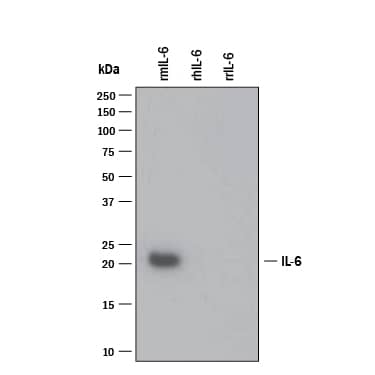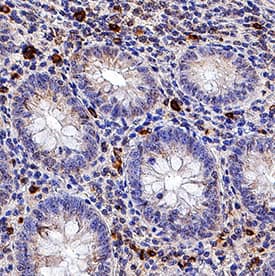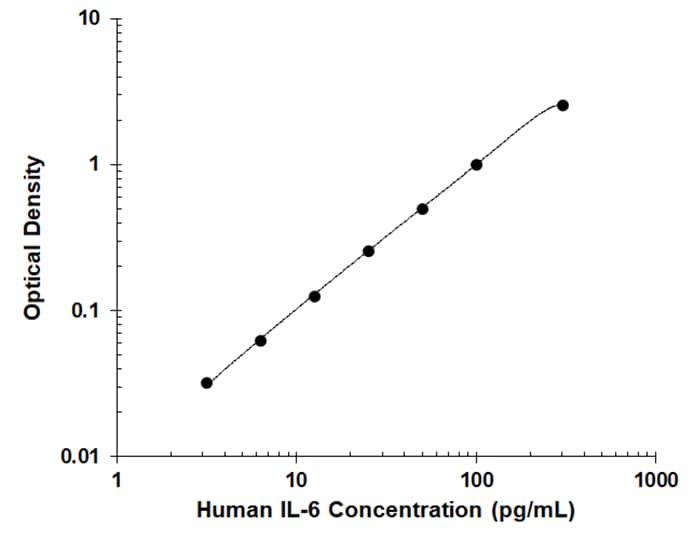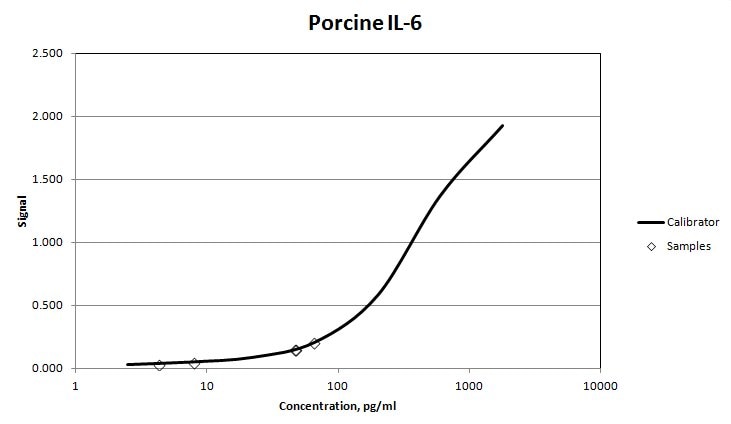Porcine IL-6 Antibody Summary
Pro29-Met212
Accession # P26893
Customers also Viewed
Applications
Porcine IL-6 Sandwich Immunoassay
Please Note: Optimal dilutions should be determined by each laboratory for each application. General Protocols are available in the Technical Information section on our website.
Scientific Data
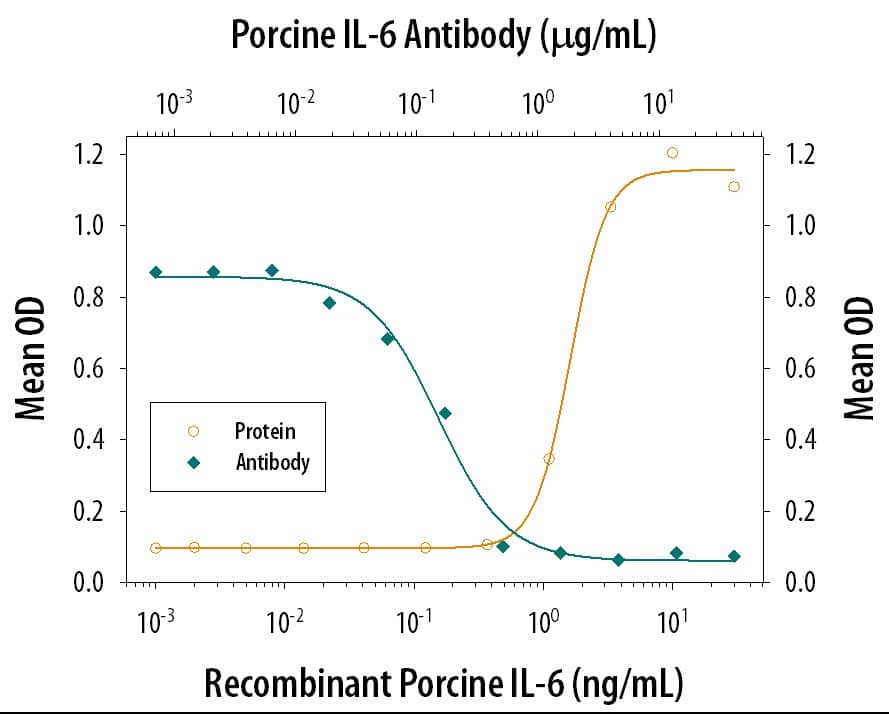 View Larger
View Larger
Cell Proliferation Induced by IL‑6 and Neutralization by Porcine IL‑6 Antibody. Recombinant Porcine IL‑6 (Catalog # 686-PI) stimulates proliferation in the T1165.85.2.1 mouse plasmacytoma cell line in a dose-dependent manner (orange line). Proliferation elicited by Recombinant Porcine IL‑6 (12.5 ng/mL) is neutralized (green line) by increasing concentrations of Goat Anti-Porcine IL‑6 Antigen Affinity-purified Polyclonal Antibody (Catalog # AF686). The ND50 is typically 0.15-0.6 µg/mL.
Preparation and Storage
- 12 months from date of receipt, -20 to -70 °C as supplied.
- 1 month, 2 to 8 °C under sterile conditions after reconstitution.
- 6 months, -20 to -70 °C under sterile conditions after reconstitution.
Background: IL-6
Interleukin 6 (IL-6) is a pleiotropic alpha -helical cytokine that plays important roles in acute phase reactions, inflammation, hematopoiesis, bone metabolism, and cancer progression. IL-6 activity is central to the transition from acute inflammation to either acquired immunity or chronic inflammatory disease. It is secreted by multiple cell types as a 22-28 kDa phosphorylated and variably glycosylated molecule (1 - 4). Mature porcine IL-6 is 183 amino acids (aa) in length and shares 61%, 42%, and 42% aa sequence identity with human, mouse, and rat IL-6 (5). IL-6 induces signaling through a cell surface heterodimeric receptor complex composed of a ligand binding subunit (IL-6 R) and a signal transducing subunit (gp130). IL-6 binds to IL-6 R, triggering IL-6 R association with gp130 and gp130 dimerization (6). gp130 is also a component of the receptors for CLC, CNTF, CT-1, IL-11, IL-27, LIF, and OSM (7). Soluble forms of IL-6 R are generated by both alternate splicing and proteolytic cleavage (3). In a mechanism known as trans-signaling, complexes of soluble IL-6 and IL-6 R elicit responses from gp130-expressing cells that lack cell surface IL‑6 R (3). Trans-signaling enables a wider range of cell types to respond to IL-6, as the expression of gp130 is ubiquitous while that of IL-6 R is predominantly restricted to hepatocytes, leukocytes, and lymphocytes (3). Soluble splice forms of gp130 block trans-signaling from IL-6/IL-6 R but not from other cytokines that utilize gp130 as a coreceptor (4, 8).
- Van Snick, J. (1990) Annu. Rev. Immunol. 8:253.
- Hodge, D.R. et al. (2005) Eur. J. Cancer 41:2502.
- Jones, S.A. (2005) J. Immunol. 175:3468.
- Rose-John, S. et al. (2006) J. Leukoc. Biol. 80:227.
- Mathialagan, N. et al. (1992) Mol. Reprod. Dev. 32:324.
- Murakami, M. et al. (1993) Science 260:1808.
- Muller-Newen, G. (2003) Sci. STKE 2003:PE40.
- Mitsuyama, K. et al. (2006) Clin. Exp. Immunol. 143:125.
Product Datasheets
Citations for Porcine IL-6 Antibody
R&D Systems personnel manually curate a database that contains references using R&D Systems products. The data collected includes not only links to publications in PubMed, but also provides information about sample types, species, and experimental conditions.
9
Citations: Showing 1 - 9
Filter your results:
Filter by:
-
Development and validation of a multiplex fluorescent microsphere immunoassay assay for detection of porcine cytokines
Authors: SA Hall, SH Ison, C Owles, J Coe, DA Sandercock, AJ Zanella
MethodsX, 2019-05-17;6(0):1218-1227.
Species: Porcine
Sample Types: Tissue Homogenates
Applications: ELISA Capture -
TRAF6 is a novel NS3-interacting protein that inhibits classical swine fever virus replication
Authors: H Lv, W Dong, Z Cao, X Li, J Wang, G Qian, Q Lv, C Wang, K Guo, Y Zhang
Sci Rep, 2017-07-27;7(1):6737.
Species: Porcine
Sample Types: Cell Culture Supernates
Applications: ELISA Development (Capture) -
Protective Role of Passively Transferred Maternal Cytokines against Bordetella pertussis Infection in Newborn Piglets
Authors: S Elahi, DR Thompson, J Van Kessel, LA Babiuk, V Gerdts
Infect. Immun., 2017-03-23;85(4):.
Species: Porcine
Sample Types: Serum
Applications: ELISA Development (Capture) -
Atorvastatin treatment improves survival and effects of implanted mesenchymal stem cells in post-infarct swine hearts.
Authors: Yang YJ, Qian HY, Huang J, Geng YJ, Gao RL, Dou KF, Yang GS, Li JJ, Shen R, He ZX, Lu MJ, Zhao SH
Eur. Heart J., 2008-05-02;29(12):1578-90.
Species: Porcine
Sample Types: Tissue Homogenates
Applications: Western Blot -
In vitro induction of mucosa-type dendritic cells by all-trans retinoic acid.
Authors: Saurer L, McCullough KC, Summerfield A
J. Immunol., 2007-09-15;179(6):3504-14.
Species: Porcine
Sample Types: Whole Cells
Applications: Neutralization -
The effect of activated protein C on plasma cytokine levels in a porcine model of acute endotoxemia.
Authors: Nielsen JS, Larsson A, Rix T, Nyboe R, Gjedsted J, Krog J, Ledet T, Tonnesen E
Intensive Care Med, 2007-04-25;33(6):1085-93.
Species: Human
Sample Types: Plasma
Applications: ELISA Development -
Cytokine responses in gnotobiotic pigs after infection with virulent or attenuated human rotavirus.
Authors: Azevedo MS, Yuan L, Pouly S, Gonzales AM, Jeong KI, Nguyen TV, Saif LJ
J. Virol., 2006-01-01;80(1):372-82.
Species: Porcine
Sample Types: Serum
Applications: ELISA Development -
Long-term effects of polymer-based, slow-release, sirolimus-eluting stents in a porcine coronary model.
Authors: Carter AJ, Aggarwal M, Kopia GA, Tio F, Tsao PS, Kolata R, Yeung AC, Llanos G, Dooley J, Falotico R
Cardiovasc. Res., 2004-09-01;63(4):617-24.
Species: Porcine
Sample Types: Tissue Homogenates
Applications: Western Blot -
Acute hyperinsulinemia restrains endotoxin-induced systemic inflammatory response: an experimental study in a porcine model.
Authors: Brix-Christensen V, Andersen SK, Andersen R, Mengel A, Dyhr T, Andersen NT, Schmitz O, Orskov H, Tonnesen E
Anesthesiology, 2004-04-01;100(4):861-70.
Species: Porcine
Sample Types: Plasma
Applications: ELISA Development
FAQs
No product specific FAQs exist for this product, however you may
View all Antibody FAQsIsotype Controls
Reconstitution Buffers
Secondary Antibodies
Reviews for Porcine IL-6 Antibody
Average Rating: 5 (Based on 2 Reviews)
Have you used Porcine IL-6 Antibody?
Submit a review and receive an Amazon gift card.
$25/€18/£15/$25CAN/¥75 Yuan/¥2500 Yen for a review with an image
$10/€7/£6/$10 CAD/¥70 Yuan/¥1110 Yen for a review without an image
Filter by:
After biotinylation, used as a capture reagent according to the manufacturer’s protocol &;Meso Scale Diagnostics LLC;. A standard curve with porcine IL-6 from RnD ;Cat# 686-PI/CF; is shown;2-25,000 pg/ml;.



